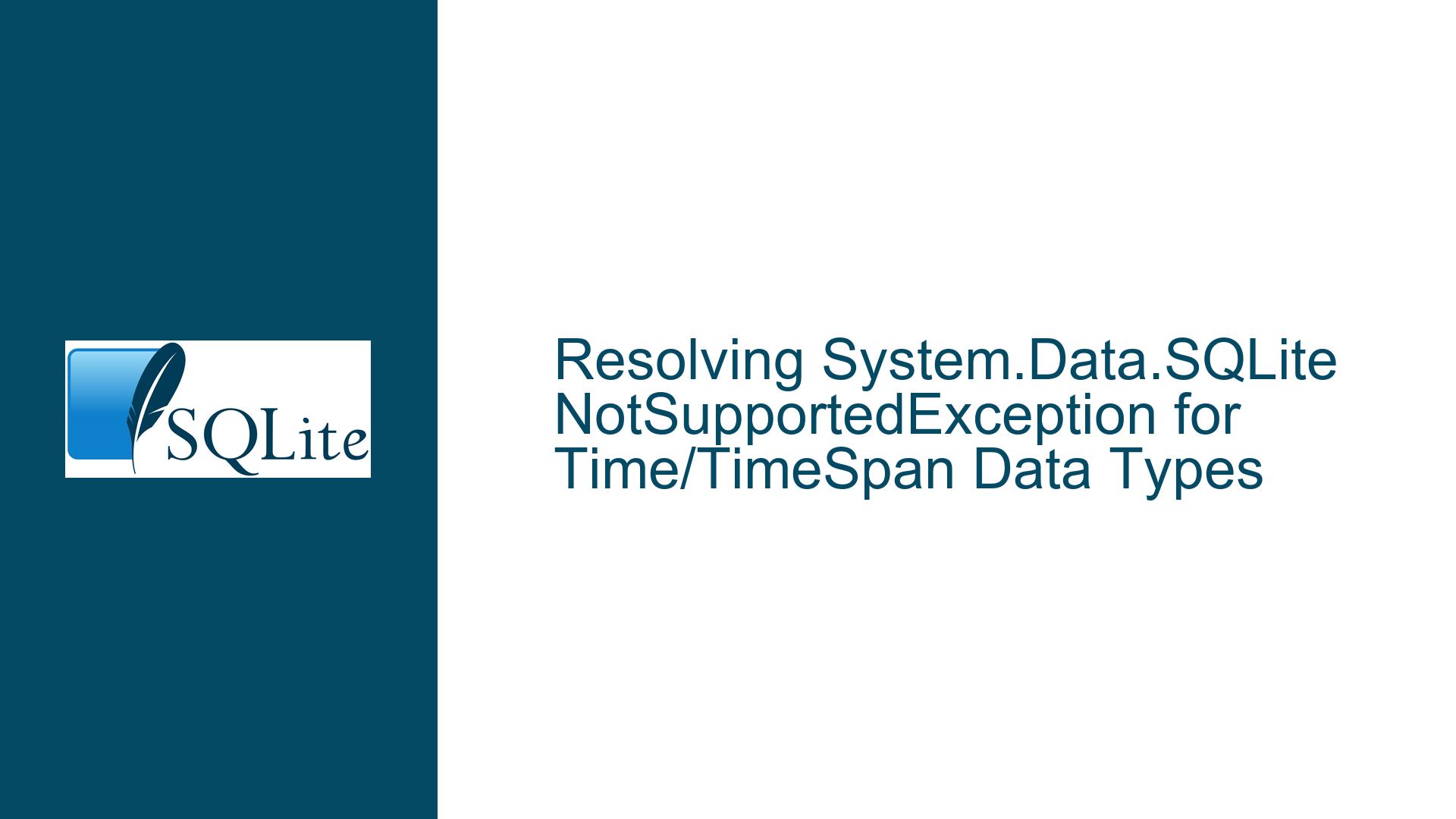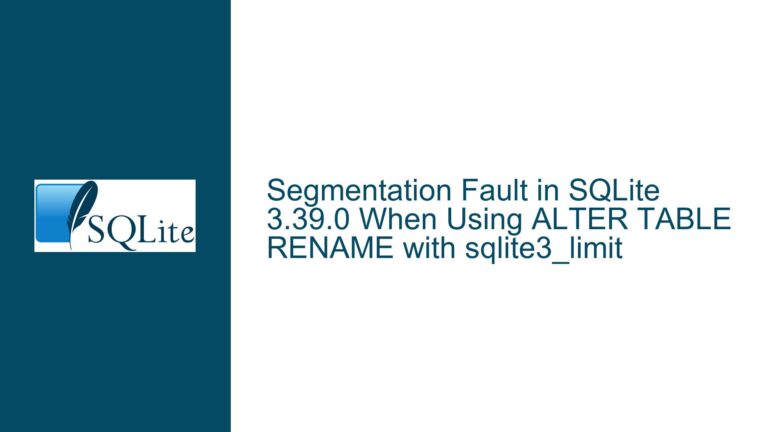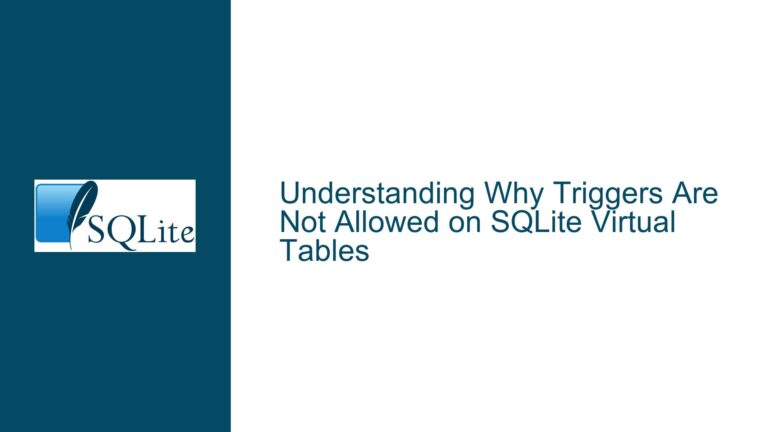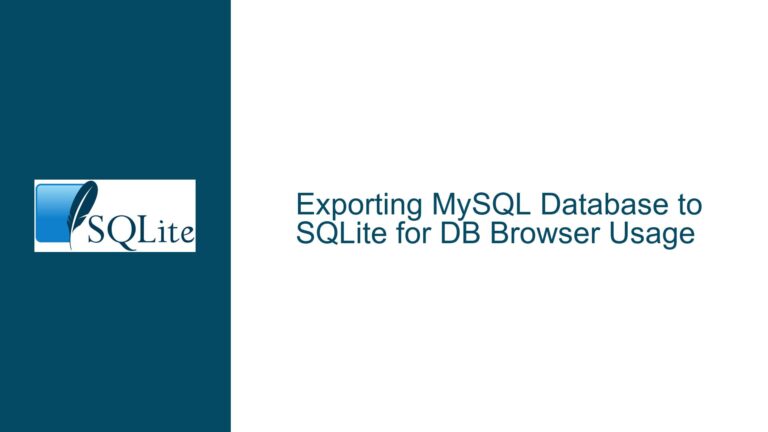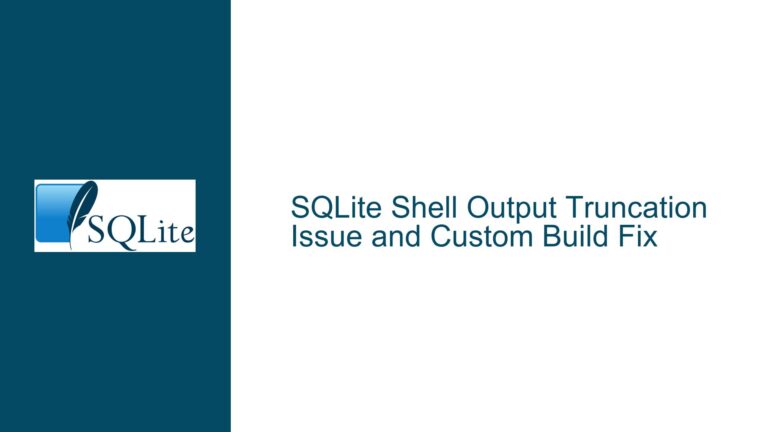Resolving System.Data.SQLite NotSupportedException for Time/TimeSpan Data Types
Understanding the System.Data.SQLite Time/TimeSpan Mapping Limitation
The System.NotSupportedException: There is no store type corresponding to the EDM type 'Edm.Time' of primitive type 'Time' error occurs when attempting to map .NET TimeSpan or TimeOnly types to SQLite database columns using Entity Framework (EF) or other ORM frameworks. This issue stems from a mismatch between the Entity Data Model (EDM) definitions and SQLite’s native type system. SQLite does not natively support a dedicated TIME data type, instead storing temporal values as TEXT, INTEGER, or REAL. The System.Data.SQLite provider (version 1.0.105.2 and earlier) lacks explicit handling for EDM’s Edm.Time type, which maps to .NET’s TimeSpan or TimeOnly structures. The problem persists even though SQLite’s core engine supports date/time functions through its date() and time() modifiers, as the ADO.NET layer requires explicit translations between .NET types and SQLite storage formats.
The GitHub commit referenced (f36e6a3d3719a4d2143363e42c929169769de364) in System.Data.SQLite 1.0.106 demonstrates an attempt to resolve this by introducing TimeSpan support via SQLiteConnection type mappings. However, version compatibility, migration complexities, and framework dependencies often prevent developers from immediately adopting newer provider versions. The absence of a standardized temporal storage convention in SQLite exacerbates the issue, as different applications may interpret TEXT columns as UTC times, local times, or durations without clear metadata.
Root Causes of the Time/TimeSpan Mapping Failure
1. SQLite’s Type Affinity System and Missing Native Time Type
SQLite employs dynamic typing with type affinity, where column types are recommendations rather than strict enforcers. A column declared as DATETIME or TIME is treated as NUMERIC or TEXT affinity. When System.Data.SQLite attempts to map Edm.Time (a high-precision temporal type) to these affinities, the provider’s internal type registry lacks a suitable conversion pathway. Unlike DateTime, which maps cleanly to TEXT in ISO8601 format (e.g., HH:mm:ss), TimeSpan represents a duration or elapsed time (e.g., 12:34:56.789) that doesn’t align with SQLite’s date/time functions expecting clock-time formats.
2. Entity Framework’s Strict EDM-to-Store Type Mapping
Entity Framework relies on the ADO.NET provider to translate EDM types (like Edm.Time) to database-specific storage types. System.Data.SQLite’s SQLiteProviderManifest class defines these mappings in its GetStoreTypes method. If Edm.Time is absent from this registry, EF throws the NotSupportedException during model validation or query execution. This gap persists in older provider versions because the TimeSpan type was historically not considered a first-class temporal type in databases, leading to its omission in early mapping tables.
3. Version-Specific Limitations in System.Data.SQLite
The System.Data.SQLite 1.0.105.2 assembly predates explicit TimeSpan support. The 1.0.106 update referenced in the GitHub commit introduces a DbType.Time mapping, which binds TimeSpan parameters to TEXT columns using HH:mm:ss.FFFFFFF formatting. However, upgrading may introduce breaking changes, such as altered DateTime parsing rules or compatibility issues with EF6 vs. EFCore. Developers often face dependency constraints (e.g., .NET Framework 4.8 vs. .NET 6) that prevent immediate adoption of newer providers.
Comprehensive Solutions for Time/TimeSpan Support in System.Data.SQLite
Step 1: Validate System.Data.SQLite Version and Dependencies
Begin by confirming the installed version of System.Data.SQLite. In Visual Studio, inspect the packages.config or .csproj file for the System.Data.SQLite package version. If using 1.0.105.2 or earlier, upgrade to 1.0.106+ via NuGet. Ensure that all projects in the solution reference the same provider version to avoid assembly binding conflicts. For projects locked into older versions due to legacy constraints, proceed to manual mapping workarounds.
Step 2: Implement Custom Type Mapping for TimeSpan
For projects stuck on System.Data.SQLite 1.0.105.2, manually map TimeSpan properties to TEXT or INTEGER columns using EF’s HasColumnType and value converters:
public class MyContext : DbContext
{
public DbSet<Event> Events { get; set; }
protected override void OnModelCreating(DbModelBuilder modelBuilder)
{
modelBuilder.Entity<Event>()
.Property(e => e.Duration)
.HasColumnType("TEXT")
.HasConversion(
v => v.ToString(), // Convert TimeSpan to string
v => TimeSpan.Parse(v) // Convert string to TimeSpan
);
}
}
public class Event
{
public int Id { get; set; }
public TimeSpan Duration { get; set; } // Maps to TEXT column
}
This approach forces EF to treat Duration as a string in the database while preserving TimeSpan semantics in code. Use INTEGER if storing ticks (e.g., v => v.Ticks and v => TimeSpan.FromTicks(long.Parse(v))).
Step 3: Modify SQLiteProviderManifest for EDM Time Mapping
Advanced users can subclass SQLiteProviderManifest to add Edm.Time support. Recompile System.Data.SQLite from source (incorporating the GitHub commit’s changes) or use reflection to patch the provider manifest at runtime:
// Runtime patch (use in static constructor or startup module)
var manifest = new SQLiteProviderManifest();
var storeTypesField = typeof(SQLiteProviderManifest)
.GetField("_storeTypeNames", BindingFlags.NonPublic | BindingFlags.Instance);
var storeTypes = (Dictionary<string, Type>)storeTypesField.GetValue(manifest);
storeTypes.Add("time", typeof(TimeSpan));
This hack injects Edm.Time into the provider’s type registry. Note that runtime reflection is fragile and may break with provider updates.
Step 4: Use SQLite’s Date/Time Functions with Caution
When querying TimeSpan values stored as TEXT, leverage SQLite’s strftime function with explicit format specifiers:
SELECT * FROM Events WHERE strftime('%H:%M:%f', Duration) > '12:00:00.000'
Ensure that all TimeSpan values are stored in a consistent format (e.g., HH:mm:ss.fffffff) to avoid parsing errors. For INTEGER (ticks), use arithmetic operations:
SELECT * FROM Events WHERE Duration > 432000000000 -- 12 hours in ticks
Step 5: Evaluate Alternative Storage Strategies
If TimeSpan precision requirements are low (e.g., hourly intervals), store time components in separate INTEGER columns:
public class Event
{
public int Id { get; set; }
public int Hours { get; set; }
public int Minutes { get; set; }
public int Seconds { get; set; }
[NotMapped]
public TimeSpan Duration
{
get => new TimeSpan(Hours, Minutes, Seconds);
set { Hours = value.Hours; Minutes = value.Minutes; Seconds = value.Seconds; }
}
}
This denormalized approach bypasses type mapping issues entirely but complicates queries involving duration arithmetic.
Step 6: Monitor Provider Updates and Community Fixes
Track the official System.Data.SQLite repository and community forks for backported fixes. If the GitHub commit is critical but unavailable in a stable release, consider compiling a custom build of System.Data.SQLite 1.0.106+ and deploying it via a private NuGet feed. Test extensively for side effects, especially around DateTimeKind handling and timezone-aware columns.
By methodically addressing version mismatches, implementing custom mappings, and cautiously leveraging SQLite’s type flexibility, developers can mitigate the Edm.Time exception while maintaining temporal data integrity. Always validate against edge cases like daylight saving time transitions and database migrations across different provider versions.
